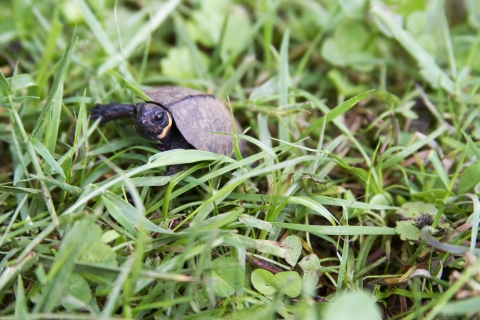Imperiled wildlife across the nation will benefit from approximately $7.6 million in grants, thanks to the U.S. Fish and Wildlife Service’s Competitive State Wildlife Grant (C-SWG) Program. The C-SWG Program provides federal grant funds to support projects implemented by state and territory agencies to benefit fish and wildlife and their habitats, especially at-risk or imperiled species.
The Wildlife and Sport Fish Restoration Program (WSFR), the program that administers the C-SWG Program, is providing funding for 16 projects and partially funding two additional projects in 2022. In the Northeast, the program is providing a total of $1.6 million to five projects this year.
“Since 2008, a portion of the State Wildlife Grant Program funding has been used for these competitive grants to encourage interstate collaboration, innovation and species conservation at larger scales to keep species from reaching the point where they are in danger of extinction or are too far gone to save,” said Service Director Martha Williams. “These grants are vital to supporting our state and territory partners as they work to recover America’s declining species and habitats.”
Conserving the nation’s biodiversity and stemming the ongoing extinction crisis is a central component of the Biden-Harris Administration’s America the Beautiful initiative, a locally led, voluntary nationwide effort to conserve, connect and restore 30 percent of lands and waters by 2030.
In the Northeast region alone, the C-SWG program has provided $18.1 million in funding and leveraged another $8.1 in match since 2008 to implement projects aimed at preventing new federal listings of threatened and endangered species and to help recover those species already listed. The program funds the full suite of conservation activities, including habitat restoration and management, land protection, research, and species reintroduction.
Funded projects in the Northeast this year include:
State agencies in Pennsylvania and Vermont will collaborate with state agency counterparts in Alabama and North Carolina to identify habitat use of Species of Greatest Conservation Need across multiple scales throughout the eastern U.S. using the Motus Wildlife Tracking System. Motus is a research network that uses automated radio telemetry to inform and enhance the conservation of migratory wildlife by placing tiny tags on animals that show their movements across the landscape.
“Abundant and healthy wildlife populations require abundant and healthy habitat. But determining what that should look like, and just where it needs to be, can be challenging, especially for species that are rare or in need of help,” said Bryan Burhans, Executive Director for the Pennsylvania Game Commission. “That’s why we’re so excited to receive this funding and be part of this larger effort. It will allow us to further focus on high-priority species using new methods and ultimately provide answers on what we can do to better the outlook for them.”
The four state fish and wildlife agencies and their additional state and nonprofit partners will establish and use 35 telemetry receiver stations to study and conserve a variety of sensitive and declining species. Targeted species include the bog turtle (federally threatened in the Northeast), golden-winged warbler (under review for federal listing), and the federally endangered gray bat.
“As part of this network of towers stretching from Maine to Florida, the migratory animals themselves - from monarchs to bats to warblers - will be telling us where, when, and with whom to focus conservation efforts,” said Doug Morin, bird project lead for Vermont Fish and Wildlife.
The Vermont Fish and Wildlife Department is working to conserve Vermont's spotted turtles using new techniques to identify unknown populations. The spotted turtle is Vermont’s rarest turtle and a high priority species in the state’s Wildlife Action Plan. The Service will be reviewing the species’ status to determine if it warrants federal protection by 2024. Project partners will identify suitable spotted turtle habitats, support the development of eDNA sampling protocols, use standardized methods to evaluate turtle presence, and improve priority nesting habitat.
“The insights and outcomes resulting from this project will be transferrable to other states with spotted turtle data gaps, and to other rare freshwater turtle species,” said Dr. Luke Groff, herpetologist for Vermont Fish and Wildlife.
The Virginia Department of Wildlife Resources will work with other state agencies in North Carolina and South Carolina and the Eastern Band of Cherokee Indians to create a comprehensive conservation and management plan for the southern lineage of the bog turtle and its associated habitats. The northern lineage of the bog turtle is classified as federally threatened, while the southern lineage, and focus of this project, is listed as threatened due to similarity of appearance.
"This multi-state partnership will not only give us updated information about the status and distribution of the southern lineage of bog turtles, but will enable us to develop conservation plans for selected high-priority habitats and continue important outreach with public and private landowners and law enforcement officials,” said John (J.D.) Kleopfer, Statewide Herpetologist for the Virginia Department of Wildlife Resources.
Virginia will also work to understand distribution and demography of saltmarsh sparrows in the understudied, southern extent of the species’ breeding range. This project seeks to determine the breeding status and distribution of the saltmarsh sparrow in Virginia, laying the groundwork for development of management actions and conservation plans. Information gained from this project will contribute to the Service’s review of the saltmarsh sparrow for potential Federal listing in 2023.
"The Eastern Shore of Virginia plays a pivotal role as the southernmost extent of nesting habitat for saltmarsh sparrows,” said Ruth Boettcher, Coastal Wildlife Biologist for Virginia Department of Wildlife Resources. “Knowing exactly where the birds are nesting will allow us to be more strategic in targeting restoration funds now and into the future."
The Northeast Association of Fish and Wildlife Agencies (NEAFWA) will work with member states to modernize the Northeast Wildlife Action Plan Database. This project builds on decades of regional collaboration among the 14-state fish and wildlife agencies that comprise NEAFWA. The partners will implement accessibility and functionality enhancements in the Northeast State Wildlife Action Plan Database. These improvements will facilitate identification of regional priorities and inform landscape-scale approaches to species and habitat conservation throughout the region.
“The Northeast Association of Fish and Wildlife Agencies has an enduring, collaborative conservation history and the Northeast Wildlife Action Plan Database has been a critical tool in identifying, prioritizing, and communicating regional conservation actions,” said Gordon R. Batcheller, Executive Secretary for NEAFWA. “We are thrilled that this critical tool will receive the necessary modernization to further enhance our effectiveness at implementing conservation priorities, thereby strengthening the important conservation work underway in the northeastern states.”
The C-SWG Program employs a nationally competitive process to select and fund projects that conserve species listed in State Wildlife Action Plans. All 56 state and territory wildlife agencies have such plans, which target state-identified Species of Greatest Conservation Need. The program facilitates collaboration among state, federal, Tribal and nongovernmental fish and wildlife managers, creating nationwide conservation networks. Fortifying this spirit of collaboration is the millions of dollars in nonfederal funds provided by states and their partners to support the selected projects.
The complete national list of 2022 SWG competitive projects can be found here: https://www.fws.gov/media/fy2022-cswg-selected-project-summariesdocx
The C-SWG Program is part of the larger SWG Program that awards grants according to a formula described in the annual appropriations act and based on a state or territory’s geographical size and population. For more information on the SWG program visit:






